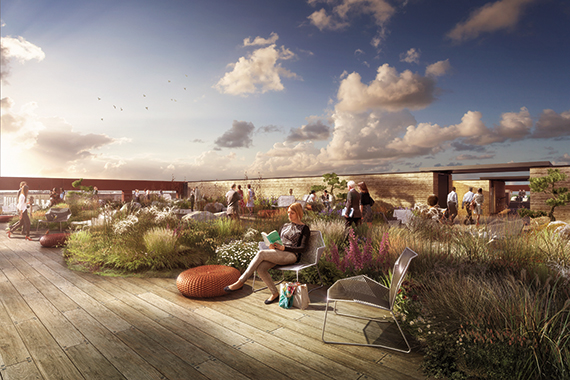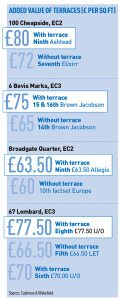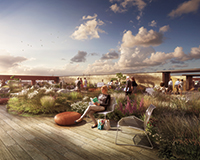 Lifts, lobbies, loos and views. Don’t snigger, these things make a big difference to occupiers. With competition for the best talent fierce, companies have to offer more than a good job and salary package. Millennials – those in their 20s and 30s – have grown up in a high-tech, flexible world and they have expectations.
Lifts, lobbies, loos and views. Don’t snigger, these things make a big difference to occupiers. With competition for the best talent fierce, companies have to offer more than a good job and salary package. Millennials – those in their 20s and 30s – have grown up in a high-tech, flexible world and they have expectations.
“Offices are becoming more like hotels. What we see more and more is that entrance halls, lifts and lobbies are important and also shower rooms, cycle storage, etc,” says John Robertson, director of John Robertson Architects.
Christopher Richmond, head of real estate at PwC, agrees: “The average age of our staff is 29 and we are constantly focusing on providing the right accommodation. It is about hospitality, concierge; all our meet-and-greet staff are from the service industry.”
Aside from the service on offer, lobbies and lift areas need to be bright and spacious. “Lobbies are hugely important, it is the first impression of the building. We talk about creating a theatre of where things are done,” he says.
Putting a value on this space and service is tricky, although in the US the property industry may be getting closer with the Delos well-building rating. This takes the BREEAM rating, currently used in the UK, to the next level, and developers such as Land Securities are already using it for guidance.
Robertson says Delos takes into consideration things such as:
● View
● Air quality
● Quality of light
● Overall experience in the building.
Neil Pennell, head of design and engineering at Land Securities, says Delos informed the developer’s approach with schemes such as the Zig Zag Building, SW1.
While lobbies are becoming more hotel-like, so too are the parts of buildings that are normally hidden from view. Toilets (see box) and stairs are two examples; the latter is increasingly an important business feature for some occupiers. Stairs are no longer just a means of moving up and down the building when staff feel energetic, they can enable valuable staff interaction.
“Stairs are not just back-of-house space now, they are all part of the experience,” says Tom Callaway, project manager at Argent. “If a building has not got it, then occupiers are asking for it.”
And by “it” he means stairs that are a feature of the office rather than hidden away behind a door. Cushman & Wakefield’s head of City agency, Andrew Parker, agrees and cites Lego Group’s offices as an example.
The firm took floors eight to 11 in New Fetter Place, EC4, but decided to punch through the floors and add in a staircase, but that is not all.
“The main lifts stop at floor eight after a certain time in the morning and, because Lego is on relatively small floorplates, what that has driven is the accidental communication between staff.”
For “accidental communication” read “collaboration”, it is what has fuelled the trend for breakout areas, bench-style desks and agile working, among other trends in office occupation. Companies love it and stairs are quickly becoming “a thing”.
Like the other, non-commercial, parts of the building, you may not be able to put a pounds per sq ft price on such features – yet – but it is increasingly part of making a building more lettable, and there is definitely value in that.
Time for a comfort break
The lav, the loo, the convenience, the washroom, whatever you call it, it is increasingly important. Just look at how they are treated from a design point of view.
“Historically, WC design was done by the architect with the least amount of experience but now developers are far more caring about the common areas having a uniform style,” says John Robertson of Roberson Architects.
Rolf McMullan, operations director at Maxwood Washrooms, says:“Having up-to-date washrooms fitted out to the highest standards is a good means of generating appeal. This is especially important where a refurbished property is in close proximity to a high-specification new-build property.”
On the terraces
Not so long ago people scoffed at the idea that the UK could have a street café culture. Look at the pavements now.
The office equivalent is the terrace – outdoor space for working, entertaining or just somewhere to sit and have lunch. Sharing that space with an occupier is good too, it encourages collaboration and networking. And here is a feature of which you can measure the value.
“It is probably anywhere between 20% and 35% added value having a terrace, excluding very high towers,” says Andrew Parker, head of City agency at Cushman & Wakefield. “There is a lot more effort to ensure that formerly redundant roof space is used. In the old days, due to planning, plant was put up there, but a lot more thought goes into that now.”
 The figures below illustrate the difference a terrace can make to rents. Click to expand.
The figures below illustrate the difference a terrace can make to rents. Click to expand.











